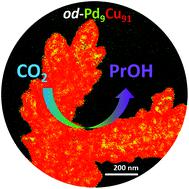当前位置:
X-MOL 学术
›
Green Chem.
›
论文详情
Our official English website, www.x-mol.net, welcomes your
feedback! (Note: you will need to create a separate account there.)
Selective n-propanol formation from CO2 over degradation-resistant activated PdCu alloy foam electrocatalysts
Green Chemistry ( IF 9.3 ) Pub Date : 2020-09-08 , DOI: 10.1039/d0gc01636e Motiar Rahaman 1, 2, 3, 4 , Kiran Kiran 1, 2, 3, 4 , Ivan Zelocualtecatl Montiel 1, 2, 3, 4 , Vitali Grozovski 1, 2, 3, 4 , Abhijit Dutta 1, 2, 3, 4 , Peter Broekmann 1, 2, 3, 4
Green Chemistry ( IF 9.3 ) Pub Date : 2020-09-08 , DOI: 10.1039/d0gc01636e Motiar Rahaman 1, 2, 3, 4 , Kiran Kiran 1, 2, 3, 4 , Ivan Zelocualtecatl Montiel 1, 2, 3, 4 , Vitali Grozovski 1, 2, 3, 4 , Abhijit Dutta 1, 2, 3, 4 , Peter Broekmann 1, 2, 3, 4
Affiliation

|
We present a novel, foam-type, high surface area electrocatalyst for the CO2 reduction reaction (CO2RR) that is not only highly selective toward n-propanol (PrOH) formation (FEPrOH = 13.7%, jPrOH = −1.15 mA cm−2) at relatively low overpotentials (−0.65 V vs. RHE) but also demonstrates an excellent long-term stability during CO2 electrolysis experiments of 102 h in duration. A dynamic hydrogen bubble template approach is applied to electrodeposit a binary PdCu alloy foam yielding a nominal bulk composition of 9 at% Pd and 91 at% Cu (denoted as Pd9Cu91). The material is further modified by means of thermal annealing (12 h at 200 °C in air), which completely transforms the as-prepared metallic Pd9Cu91 alloy foam into its oxidic state. The ultimate catalyst activation is achieved by subsequent reduction (at −0.65 V vs. RHE for 45 min) of the oxidic precursors (composite of Cu2O, CuO, and CuPdO3) into metallic state, as indicated by operando Raman spectroscopy. Identical location scanning electron microscopy (IL-SEM) analysis, carried out prior to and after the activation treatments, demonstrates significant morphological alterations of the Pd9Cu91 foam on the nm length scale, which go along with a phase segregation into nm-range Pd-rich and Cu-rich domains that helps to increase the PrOH selectivity. Time-dependent ICP-MS analyses of the electrolyte solution, carried out during the catalyst activation, demonstrate preferential (rapid) Cu dissolution followed by (slow) Cu redeposition on the catalyst surface. These processes are found to be superimposed on the actual oxide reduction. A two-fold selectivity of PrOH was observed over ethanol (EtOH). The excellent long-term stability of the activated Pd9Cu91 foam catalyst is rationalized by the full suppression of the C1 hydrocarbon (methane) pathway. The improved product selectivity towards the highly valuable C3 alcohol is rationalized by an efficient and concerted spillover of chemisorbed carbon monoxide (*CO) and atomic hydrogen (*H) species from the Pd-rich domains to the activated Cu-rich domains of the oxide-derived Pd9Cu91 foam catalyst where the C–C coupling and subsequent hydrogenation processes take place to form the targeted oxygenate product.
中文翻译:

在耐降解的活化PdCu合金泡沫电催化剂上由CO2选择性形成正丙醇
我们提出了一种新颖的,泡沫型,高表面积的CO 2还原反应(CO 2 RR)电催化剂,该催化剂不仅对正丙醇(PrOH)形成具有高选择性(FE PrOH = 13.7%,j PrOH = -1.15 mA cm -2)在相对较低的过电势下(相对于RHE为-0.65 V ),但在102 h的CO 2电解实验中也表现出出色的长期稳定性。应用动态氢气泡模板方法来电沉积二元PdCu合金泡沫,产生9at%Pd和91at%Cu(标为Pd 9 Cu 91)。该材料通过热退火(在200°C的空气中12 h)进一步改性,这将所制备的金属Pd 9 Cu 91合金泡沫完全转变成其氧化态。如操作拉曼光谱法所示,通过随后将氧化前体(Cu 2 O,CuO和CuPdO 3的复合物)还原为金属态(在-0.65 V vs. RHE下45分钟),可以实现最终的催化剂活化。在活化处理之前和之后进行的相同位置扫描电子显微镜(IL-SEM)分析表明,Pd 9 Cu 91的形态发生了显着变化在纳米级尺度上形成泡沫,其相分离成纳米范围的富Pd和富Cu区域,有助于提高PrOH的选择性。在催化剂活化过程中对电解质溶液进行随时间变化的ICP-MS分析,结果表明优先(快速)铜溶解,然后(缓慢)铜再沉积在催化剂表面。发现这些过程叠加在实际的氧化物还原上。观察到PrOH的选择性是乙醇(EtOH)的两倍。活化的Pd 9 Cu 91的出色的长期稳定性通过完全抑制C1碳氢化合物(甲烷)途径,使泡沫催化剂合理化。化学吸附的一氧化碳(* CO)和原子氢(* H)物种从富Pd区域到活化的富Cu区域的有效且协调的溢出,可以合理地提高对高价值C3醇的产品选择性衍生的Pd 9 Cu 91泡沫催化剂,在其中进行C-C偶联和随后的加氢过程以形成目标的含氧产物。
更新日期:2020-10-05
中文翻译:

在耐降解的活化PdCu合金泡沫电催化剂上由CO2选择性形成正丙醇
我们提出了一种新颖的,泡沫型,高表面积的CO 2还原反应(CO 2 RR)电催化剂,该催化剂不仅对正丙醇(PrOH)形成具有高选择性(FE PrOH = 13.7%,j PrOH = -1.15 mA cm -2)在相对较低的过电势下(相对于RHE为-0.65 V ),但在102 h的CO 2电解实验中也表现出出色的长期稳定性。应用动态氢气泡模板方法来电沉积二元PdCu合金泡沫,产生9at%Pd和91at%Cu(标为Pd 9 Cu 91)。该材料通过热退火(在200°C的空气中12 h)进一步改性,这将所制备的金属Pd 9 Cu 91合金泡沫完全转变成其氧化态。如操作拉曼光谱法所示,通过随后将氧化前体(Cu 2 O,CuO和CuPdO 3的复合物)还原为金属态(在-0.65 V vs. RHE下45分钟),可以实现最终的催化剂活化。在活化处理之前和之后进行的相同位置扫描电子显微镜(IL-SEM)分析表明,Pd 9 Cu 91的形态发生了显着变化在纳米级尺度上形成泡沫,其相分离成纳米范围的富Pd和富Cu区域,有助于提高PrOH的选择性。在催化剂活化过程中对电解质溶液进行随时间变化的ICP-MS分析,结果表明优先(快速)铜溶解,然后(缓慢)铜再沉积在催化剂表面。发现这些过程叠加在实际的氧化物还原上。观察到PrOH的选择性是乙醇(EtOH)的两倍。活化的Pd 9 Cu 91的出色的长期稳定性通过完全抑制C1碳氢化合物(甲烷)途径,使泡沫催化剂合理化。化学吸附的一氧化碳(* CO)和原子氢(* H)物种从富Pd区域到活化的富Cu区域的有效且协调的溢出,可以合理地提高对高价值C3醇的产品选择性衍生的Pd 9 Cu 91泡沫催化剂,在其中进行C-C偶联和随后的加氢过程以形成目标的含氧产物。











































 京公网安备 11010802027423号
京公网安备 11010802027423号